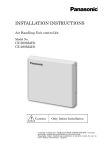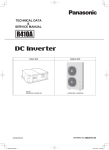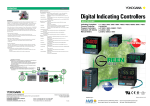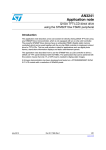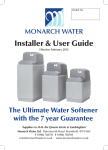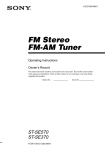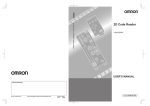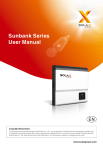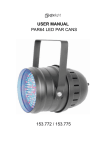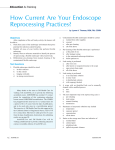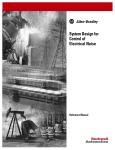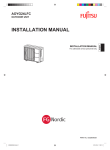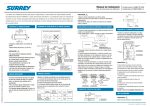Download CZ-PAH1 AHU Controller Installation Manual
Transcript
INSTALLATION INSTRUCTIONS Air Handling Unit control kit Model No. CZ-280PAH1 Caution Only Indoor Installation Carefully reading this ”INSTALLATION INSTRUCTIONS”, correctly and safely conducting installation or electrical work. Especially, before conducting installation or electrical work, be sure to read ” Safety Precautions”(page3). Contents 1. Safety Precautions 3 2. System Lineup 4 3. Supplied Parts 4 4. Outside View 4 5. Control Box Configuration 5 6. System Overview 5 7. Limitation of AHU 6 7.1. Temperature range 6 7.2. Inside volume of heat exchanger 6 7.3. Air volume of AHU 6 7.4. Front area of heat exchanger 6 7.5. Restriction of the number of passes of the heat exchanger hairpin 6 8. Installation 7 8.1. AHU kit Installation 7 8.2. Piping Installation 8 8.3. Thermistor Installation 9 8.4. Capacity disregard of circuit board in outdoor unit 10 8.5. Remote Controller Installation(Option parts) 11 9. Electrical Wiring 13 9.1. General Precautions on Wiring 13 9.2. Recommended Wire Length and Wire Diameter for Power Supply System 13 9.3. Wiring System Diagrams 14 9.4. How to connect wiring to the terminal 16 9.5. Connecting Distant Signal Line 17 10. Test Run 18 Warranty policy We are held responsible for the quality and performance of the AHU kit we supply, but not held responsible for the performances, operations and machine controls of your complete AHU system which incorporates our AHU kit. We are not held responsible for the components used in the refrigerant cycle of your AHU system either. Such components are, but not limited to, Compressors, High-pressure switches, Check valves, Strainers, Expansion valves, Solenoid valves, 4-way valves, Capillary tubes, Accumulator tanks, Heat exchanger tubes. We are not held responsible for any damages and defects caused in the process of installing our AHU kit, by the system design and/or during assembly of your AHU system. We do not publish the certificate to show conformity to the EMC and the product safety requirements applicable to your complete AHU system. 2 1. Safety Precautions z Before conducting installation or electrical work, be sure to carefully read these” Safety Precautions”. Follow instructions exactly in all installation or electrical work. z The following symbols used in this manual, alert you to potentially dangerous conditions to users, service personnel or the appliance: Warning This warning mark indicates that “A possibility of serious injury or death exists”. Caution This cautionary mark indicates that “A possibility of injury or damage to property exists”. Warning z Be sure to arrange installation at the dealer where the system was purchased or use a professional installer. Leaks, electric shock or fire may result if an inexperienced person performs any installation or wiring procedures incorrectly. z Installation should be performed exactly according to the “Installation Instructions”. Electric shock or fire may result if an inexperienced person performs any installation or wiring procedures incorrectly. z Only a qualified electrician should attempt to install this system, in accordance with the provisions of “Installation Instructions”. Be sure to use a dedicated electrical circuit. Insufficient electrical circuit capacity or inadequate workmanship may cause electric shock or fire. z Always use a dedicated branch circuit for electrical wiring. Do not use with any other electric devices. Use with other electric devices may result in circuit breaker breaks. z Use the specified cables (type and wiring diameter) for the electrical connections, and securely connect the cables. Run and fasten the cables securely so that external forces or pressure placed on the cables will not be transmitted to the connection terminals. Overheating or fire may result if connections or attachments are not secure.] z Install so that even if cooling gas leaks into the room, it will not exceed the limit density of 0.3kg/m3, in accordance with the standard for facility air conditioning equipment (S0010). If it does exceed the limit density, install an opening in a neighboring room, or install ventilation equipment triggered by gas leak detection sensors. Suffocation can result if cooling gas leaks and exceeds the limit density in a small room. z Install in a location that is fully strong enough to support the weight of the equipment. If it is not strong enough, the equipment may fall, resulting in injury. z Perform installation that is secure enough to withstand earthquakes, and typhoons and other strong winds. Incorrect installation can result in falling equipment and other accidents. z Ventilate the work area if cooling gas leaks during installation. Poisonous gas can result if cooling gas comes into contact with fire. z After installation of cooling pipes, perform a nitrogen gas sealing test to check that there are no leaks. Poisonous gas can result if cooling gas leaks into the room and comes into contact with a fan heater, stove, range, or other source of fire. Caution z When handling cooling gas, be careful not to touch the cooling gas directly. Frostbite injuries can occur. z Do not install the system in locations where flammable gas can be generated, enters, build up, or leak. Do not install in locations where volatile inflammable materials are handled. Flammable gas or inflammable materials may ignite, cause fires. z Be sure to ground equipment properly. Do not attach ground wires to gas pipes, water pipes, lightning arresters, or telephone ground lines. Failure to ground completely can cause electric shock. z Always install an earth leakage breaker. Failure to install an earth leakage breaker can cause shock and fires. 3 2. System Lineup Capacity 10kW 12.5kW 14kW 20kW 25kW Outdoor combination U-100PE1E8 U-100PE1E5 U-125PE1E8 U-125PE1E5 U-140PE1E8 U-140PE1E5 - U-200PE1E8 - U-250PE1E8 Connectable AHU-kit combination CZ-280PAH1 CZ-280PAH1 CZ-280PAH1 CZ-280PAH1 CZ-280PAH1 CZ-280PAH1 - CZ-280PAH1 - CZ-280PAH1 *Single connection type only. *Mix connection with standard indoor units is not allowed. *Applicable system is only above. 3. Supplied Parts Part name Self DrillingScrew (4x13) Form Quantity Notes 7 For fixing the product. (Kit and its bracket) Screw(4x8) 2 For attaching (option parts) Bracket 1 For supporting the product. At the time of shipment, be glued to the back of the product. Installation Instructions User’s manual remote controller. 1 AHU System Check list 1 For selection of AHU and operating test run. Insulation 2 For thermistor insulation Clamper 5 For fixing thermistor ,and making wire down to Blower signal line. Thermistor 3 Attached to the body of AHU kit. Notes 1 Paste notes on an outdoor unit. 4. Outside View Weight of the control box:6.3kg 4 5. Control Box Configuration ① PCB(main) ② Transformer ③ Magnetic relay ④ Terminal(power supply, control line) ⑤ Terminal(Blower signal line) ⑥ Space Optional controller installation (for Mini Seri-Para I/O unit <CZ-CAPBC2>) 6. System Overview Single connection Strainer(Liquid pipe & Gas pipe)Minφ25.4、 #100(Field supplied) A:AHU kit controller box (with control PCB) B:AHU equipment (Field supplied) C:Remote controller (option parts) D:Outdoor unit E:Gas piping (Field supplied) F:Liquid piping (Field supplied) G:Thermistor for Liquid pipe(E1) H:Thermistor for Heat exchanger pipe middle(E2) I:Thermistor for Suction air(TA) J:Inter unit wiring K:Magnetic relay for operating the blower(Field supplied) 5 7. Limitations of AHU 7.1. Temperature Range The limitation of temperature range is below. Outdoor temperature Inter air temperature (to the heat exchanger) Cooling -10℃(DB) 43℃(DB) 18℃(DB) 32℃(DB)/23℃(WB) Minimum Maximum Minimum Maximum Heating -20℃(WB) 15℃(WB) 16℃(DB) 30℃(DB) 7.2. Inside Volume of Heat Exchanger Capacity(Cooling) Heat exchanger Maximum volume Minimum kW dm3 dm3 10 2.1 1.7 12.5 2.1 1.7 14 2.1 1.7 20 4.3 2.3 25 4.3 2.7 7.3. Air Volume of AHU Capacity(Cooling) Maximum Air volume Minimum kW m3/h m3/h 10 1980 840 12.5 2100 1140 kW ㎡ ㎡ 10 0.51 0.43 12.5 0.51 0.43 14 2160 1140 20 3960 1680 25 4440 2280 7.4. Front Area of Heat Exchanger Capacity(Cooling) Maximum The frontal area Minimum 14 0.51 0.43 20 1.0 0.54 25 1.0 0.66 7.5. Restriction of the Number of Passes of the Heat Exchanger Hairpin Minimum number of passes =The number of steps×Distance between tube sheets×The number of rows×1.5×10-4 <For example> The number of steps: 12 Distance between tube sheets : 1000[mm] The number of rows : 3 ∴Minimum number of passes = 12×1000×3×1.5×10-4 = 5.4 < 6 passes Caution Outdoor unit has a switch for high-pressure. Air-conditioning unit stops the operation for protection when high-pressure gets higher. Pressure switch sometimes operates in Heating mode when the position of setting Heat exchanger pipe Thermistor (E2) is not proper or how to set it is not proper. 6 8. Installation 8.1. AHU kit Installation Mount AHU kit according to the following instructions. * Attach AHU kit to Air Handling Unit body directly to avoid exposing wires of thermistors to outside. 1. Install the bracket to the wall with the screws.(Three screws) 2. Make two holes. (for wirings) The position of wires holes of AHU kit 120mm 6mm 25mm 7mm 113mm 70mm 3. Hang the kit on the bracket. 4. Remove the two screws on the right side of the unit. (Support the unit with your free hand while removing the screws.) 300mm Obstacle 5. Open the front panel and fix the unit to the wall with the screws.(4 screws) 7 8.2. Piping Installation 8.2.1. Dimension of connecting pipe to heat exchanger of AHU Capacity 10-14kW Model name CZ-280PAH1 Liquid pipe Φ9.52mm Gas pipe Φ15.88mm 20kW CZ-280PAH1 Φ9.52mm Φ25.4mm 25kW CZ-280PAH1 Φ12.7mm Φ25.4mm 8.2.2. System piping length(Charging with refrigerant) At the time of shipment from the factory, Outdoor unit is charged with enough refrigerant for an equivalent pipe length of 30m. If the equivalent pipe length used will be 30m or less, no additional charging will be necessary. If the equivalent pipe length will be between 30 and 50 / 70m, charge with additional refrigerant according to the equivalent length given in the table below. Capacity 10-14kW Additional charging amount 50g/m Equivalent length 50m Minimum length 5m 20kW 40g/m 70m 5m 25kW 80g/m 70m 5m 8.2.3. Installation of Strainer(Field supplied) Attach the Strainer to the side of the outdoor unit for GAS & LIQUID piping. (Refer to 6 System Overview of page 5) 8 8.3. Thermistor Installation Identify the thermistors by the tag which is wound to each thermistor. * Don’t put wires out of equipment. * Don’t cut wires and don’t detach connecter of wires. 8.3.1. Caution for Thermistor Installation Attach the head of thermistor exactly onto the pipe because the head is most sensitive point of the thermistor. Put the thermistor wire down to avoid water to the thermistor. Maximize the contact Most sensitive point of the thermistor Insert thermistor wire down into AHU body. The wire down is close to AHU kit. Inside of AHU AHU kit Wire Down Drooping Wire 8.3.2. Thermistor Installation for Liquid Pipe Put “E1” thermistor to liquid pipe of AHU heat exchanger according to the step below. 1. Attach the liquid thermistor to the liquid pipe located in the lowest position after distributer in heat exchanger. 2. Cover the thermistor and pipe with aluminum tape. 3. Cover the aluminum tape with thermal insulation. 4. Thermal insulation and wiring are fixed by two bands. Then, it must not make tension to the wire. Put the thermistor wire down 9 8.3.3. Installation of “E2”Thermistor for Heat exchanger Pipe middle 1. Attach the heat exchanger pipe middle thermistor in the middle of each pass-line (pipe) in the heat exchanger. 3. The thermistor is fixed in bands. Then, it must not make tension to the wire. 2. Cover the thermistor and pipe with aluminum tape(Field supply). 4. Cover the aluminum tape with thermal insulation. And also cover Sensor(Copper portion) with thermal insulation completely. 8.3.4. Thermistor Installation for Air (Suction ) Attach Suction Thermistor (TA) to the position where air suction temperature can be measurable. 8.4. Capacity Disregard of Circuit Board in Outdoor Unit Cut the wire for jumping to “JP001(Capacity disregard)” on circuit board in outdoor unit. Remote Controller displays “E15, E16(Error message)” when not cutting it. Take off cut jumper leads. 10 8.4.1. Attachment of NOTES Label.(Supplied parts) Please be sure to place the attached NOTES label on the following designated area in Outdoor Unit when cutting jumper wire on circuit board in Outdoor Unit. Model name U-100PE1E8 U-125PE1E8 U-140PE1E8 U-100PE1E5 U-125PE1E5 U-140PE1E5 U-200PE1E8 U-250PE1E8 NOTES NOTES 8.5. Remote Controller Installation (Option parts) When you install a remote controller (Option parts), follow the steps below. ① Remove the front panel 1. Remove the two screws on the right side of the unit. 3. Remove the screw and washer fixing film on the front panel. 2. Open the front panel. 4. Remove hinges and lift up the front panel. 11 ② Make holes on the front panel Make holes (x3) correctly at the following position. (2 screw holes, a wire hole) Caution 2×Φ3.1mm Hole for screws of remote controllerLess installation than 180mm Φ10mm Hole for remote control lerfor wiring Hole remote controller wiring If the hole position is wrong or different, the electrical equipment parts in the box and the wires may be damaged and cause the trouble. Φ10mm Hole 2×Φ3.1mm Hole Front view Top view ③ Remote controller installation 1. Push the driver into the groove of the lower body of the remote control, and then remove the lower case. 2. Fixed the case of the remote control with screws onto the front panel. 3. Connect the remote control wiring to the main PCB of AHU kit. 4. Fit the body of the remote control to the lower case, and then install it. Hole for remote controller wiring Caution Use the two screws(4x8) that come with this AHU kit instead of the four screws that come with the remote controller. Lower case of the remote controller Screw(4x8)×2 (Supplied Parts) Hole for remote controller installation Body of the remote controller ④ Attach the front panel 1. Replace front panel. 2. Fix the film to the front panel with the screw and washer. 3. Close the front panel. 4. Replace the two screws on the right side of the unit. 12 9. Electrical Wiring 9.1. General Precautions on Wiring (1) Before wiring, confirm the rated voltage of the unit as shown on its nameplate, then carry out the wiring closely following the wiring diagram. (2) This equipment is not provided with a power supply cord. Circuit breaker must be incorporated in the fixed wiring in accordance with national wiring regulations. The circuit breaker must be approved, suitable for the voltage and current ratings of equipment and have a contact separation in all poles. (3) To prevent possible hazards from insulation failure, the unit must be grounded. (4) Each wiring connection must be done in accordance with the wiring system diagram. Wrong wiring may cause the unit to misoperate or become damaged. (5) Do not allow wiring to touch the refrigerant tubing, compressor, or any moving parts of the fan. (6) Unauthorized changes in the internal wiring can be very dangerous. The manufacturer will accept no responsibility for any damage or misoperation that occurs as a result of such unauthorized changes. (7) Regulations on wire diameters differ from locality to locality. For field wiring rules, please refer to your LOCAL ELECTRICAL CODES before beginning. You must ensure that installation complies with all relevant rules and regulations. (8) To prevent malfunction of the air conditioner caused by electrical noise, care must be taken when wiring as follows: ● The remote control wiring and the inter-unit control wiring should be wired apart from the inter-unit power wiring. ● Use shielded wires for inter-unit control wiring (between units) and ground the shield on both sides. (9) If the power supply cord of this appliance is damaged, it must be replaced by a repair shop designated by the manufacture, because special-purpose tools are required. 9.2. Recommended Wire Length and Wire Diameter for Power Supply System Type AHU kit controller (B) Power supply 2.5mm2 Max. 150m Time delay fuse or circuit capacity 10-16 A Control wiring (C) Inter-unit (between outdoor and indoor units) control wiring 0.75mm2 (AWG#18) Use shielded wiring* Max. 1,000m (D) Remote control wiring 0.75 mm2 (AWG#18) Max. 500m *For ”(A) Power supply of outdoor unit”, refer to “INSTALLATION INSTRUCTIONS” of outdoor unit. 13 9.3. Wiring System Diagrams Fig.9-1 (1) Refer to Section 9.2. “Recommended Wire Length and Wire Diameter for Power Supply System” for the explanation of “A”, “B”, “C” and “D” in the above diagram. (Fig.9-1) (2) The basic connection diagram of the indoor unit shows the terminal boards, so the terminal boards in your equipment may differ from the diagram.(Fig.9-2) (3) Refrigerant Circuit (R.C.) address should be set before turning the power on. (4) Regarding R.C. address setting, refer to the installation instructions supplied with the remote controller unit(optional). Auto address setting can be executed by remote controller automatically. Refer to the installation instructions supplied with the remote controller unit(optional). 14 Fig.9-2 (1) When linking the outdoor units in a network, disconnect the terminal extended from the short plug from all outdoor units except any one of the outdoor units. (When shipping: in shorted condition.) For a system without link(no wiring connection between outdoor units), do not remove the short plug. (2) Do not install the inter-unit control wiring in a way that forms a loop.(Fig.9-3) Fig.9-3 (3) Do not install inter-unit control wiring such as star branch wiring. Star branch wiring causes mis-address setting.(Fig.9-4) Fig.9-4 (4) If branching the inter-unit control wiring, the number of branch points should be 16 or fewer.(Branches that are less than 1m are not included in the total branch number.)(Fig.9-5) Fig.9-5 (5) Use shielded wires for inter-unit control wiring(c) which shielded woven mesh grounded on both sides, otherwise misoperation from noise may occur.(Fig.9-6) Connect wiring as shown in Section” 9.3.Wiring System Diagrams”. Fig.9-6 (6) Use the standard power supply cables for Europe (such as H05RN-F or H07RN-F which conform to CENELEC(HAR) rating specifications) or use the cables based on IEC standard.(245 IEC57, 245 IEC66) 15 Loose wiring may cause the terminal to overheat or result in unit malfunction. A fire hazard may also occur. Therefore, ensure that all wiring is tightly connected. When connecting each power wire to the terminal, follow the instructions on “How to connect wiring to the terminal” and fasten the wire securely with the terminal screw. 9.4. How to Connect Wiring to the Terminal ■ For stranded wiring (1) Cut the wire end with cutting pliers, then strip the insulation to expose the stranded wiring by about 10mm and tightly twist the wire ends. (Fig.9-7) (2) Using a Phillips head screwdriver, remove the terminal screw(s) on the terminal plate. (3) Using a ring connector fastener or pliers, securely clamp each stripped wire end with a ring pressure terminal. (4) Place the ring pressure terminal, and replace and tighten the removed terminal screw using a screwdriver.(Fig.9-8) Fig.9-7 Fig.9-8 ■ Examples of shield wires (1) Remove cable sheath not to scratch braided shield. (Fig.9-9) (2) Unbraid the braided shield carefully and twist the unbraided shield wires tightly together. Insulate the shield wires by covering them with an insulation tube or wrapping insulation tape around wire. (Fig.9-10) (3) Remove insulation of signal wire.(Fig.9-11) (4) Attach ring pressure terminals to the signal wires and the shield wires insulated in Step (2).(Fig.9-12) Use this screw when connecting the shield for the inter-unit control wiring to ground Fig.9-10 Fig.9-11 Fig.9-12 Remote Control Wiring Power Supply Fig.9-9 Inter-unit Control Wiring 16 9.5. Connecting Distant Signal Line(Blower signal and Blower protect) Blower signal and Blower protect are connected from this hole and fixed by clamper. Inside of AHU Blower signal and Blower protect Clamper(Supplied parts) Drooping wire Make wire down to Blower signal and Blower protect by clamper(Supplied parts) so as to avoid water into AHU kit. ■ Blower signal output A fan control. It is usually at ON position at the time of operating, but it becomes OFF in defrosting. ■ Blower protect input If a switch opens, an alarm “P01” appears on a remote control display, and stop operation stops. 17 10. Test Run Operate Test Run according to “10.PRECAUTIONS REGARDING TEST RUN”(10-14kW), “9.TEST RUN” (20-25kW) which is in INSTALLATION INSTRUCTIONS of Outdoor Unit and “AHU System Check List” which is an accessory of this product. If alarm messages are indicated on the outdoor unit PCB (blink of LED) or the wired remote controller, refer to“Check self-diagnosis label attached on the reverse side of the panel for checking the Unit.”(10-14kW) “9-7. Table of Self-Diagnostic Fanctions and Corrections” (20-25kW) which is in INSTALLATION INSTRUCTIONS of Outdoor Unit. 18 PA0612-1082 Authorized representative in EU Panasonic Testing Centre Panasonic Marketing Europe GmbH Winsbergring 15, 22525 Hamburg, Germany 85464369641001 Printed in Japan Service Part No, CV6233211466



















